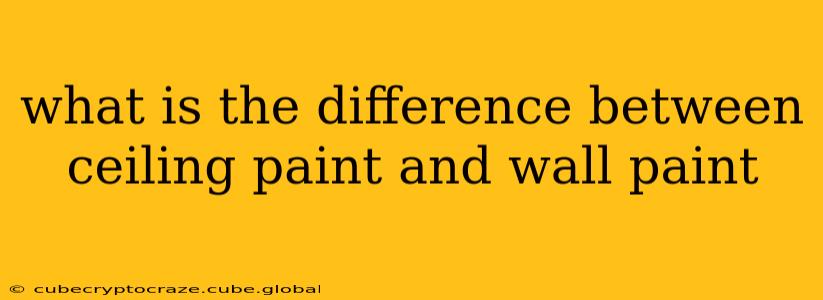Choosing the right paint for your walls and ceiling can seem daunting, especially with the vast array of options available. While both wall and ceiling paints are designed to protect and beautify your interior surfaces, crucial differences exist in their formulations, making them unsuitable for swapping. This article will delve into those key distinctions and help you choose the right paint for each surface.
Why Use Different Paint for Walls and Ceilings?
The fundamental difference lies in the paint's properties, specifically its sheen, durability, and hiding power. Ceilings typically require a paint that's easy to apply, dries quickly, and effectively hides imperfections, while wall paints prioritize washability and stain resistance.
What are the Key Differences in Sheen?
Sheen refers to the level of gloss or shine in the paint. Ceiling paint is usually formulated with a flat or matte finish. This low-sheen finish helps to minimize the appearance of imperfections and any texture on the ceiling, which often shows more readily due to lighting. Wall paints, however, offer a broader range of sheens, from flat to high-gloss, allowing for personalization based on the room's style and desired level of durability and washability. A glossier finish on walls is easier to clean.
Durability and Washability: A Critical Distinction
Ceiling paint prioritizes ease of application and hiding power. It's often not designed for high levels of scrubbing or frequent cleaning, as ceilings generally don't experience the same level of wear and tear as walls. Wall paints, however, are formulated with greater durability and washability, making them more resistant to scuffs, marks, and stains from everyday activities. This is particularly important in high-traffic areas like hallways or children's rooms.
Hiding Power: The Importance of Imperfections
Both ceiling and wall paints aim for good hiding power (the ability to cover imperfections), but the formulation differs. Ceiling paint generally excels at masking minor imperfections, thanks to its flatter finish and often thicker consistency. This is beneficial because ceilings often have slight textural variations, which a flat finish can better conceal. Wall paint, while also possessing hiding power, might not be as effective at masking significant imperfections.
What if I Use Wall Paint on the Ceiling?
While it's possible to use wall paint on your ceiling, it's generally not recommended. The higher sheen might highlight imperfections and make the ceiling look uneven. The thicker consistency can also make application more difficult, resulting in drips and an uneven finish.
What if I Use Ceiling Paint on the Walls?
Similarly, using ceiling paint on walls is not ideal. The low durability and washability of ceiling paint make it less resistant to cleaning and wear. Scuffs and stains will be much more difficult to remove, leading to a less aesthetically pleasing and potentially unsanitary surface.
How to Choose the Right Paint for Your Project
Consider the following factors when choosing paint:
- Surface: Walls or ceilings? This dictates the appropriate sheen and durability.
- Location: High-traffic areas need more durable paints.
- Desired finish: From matte to high-gloss, the sheen impacts the look and feel.
- Budget: Paint prices vary based on quality and features.
By understanding the differences between ceiling and wall paints, you can ensure a professional-looking, durable, and long-lasting finish for both surfaces in your home.
